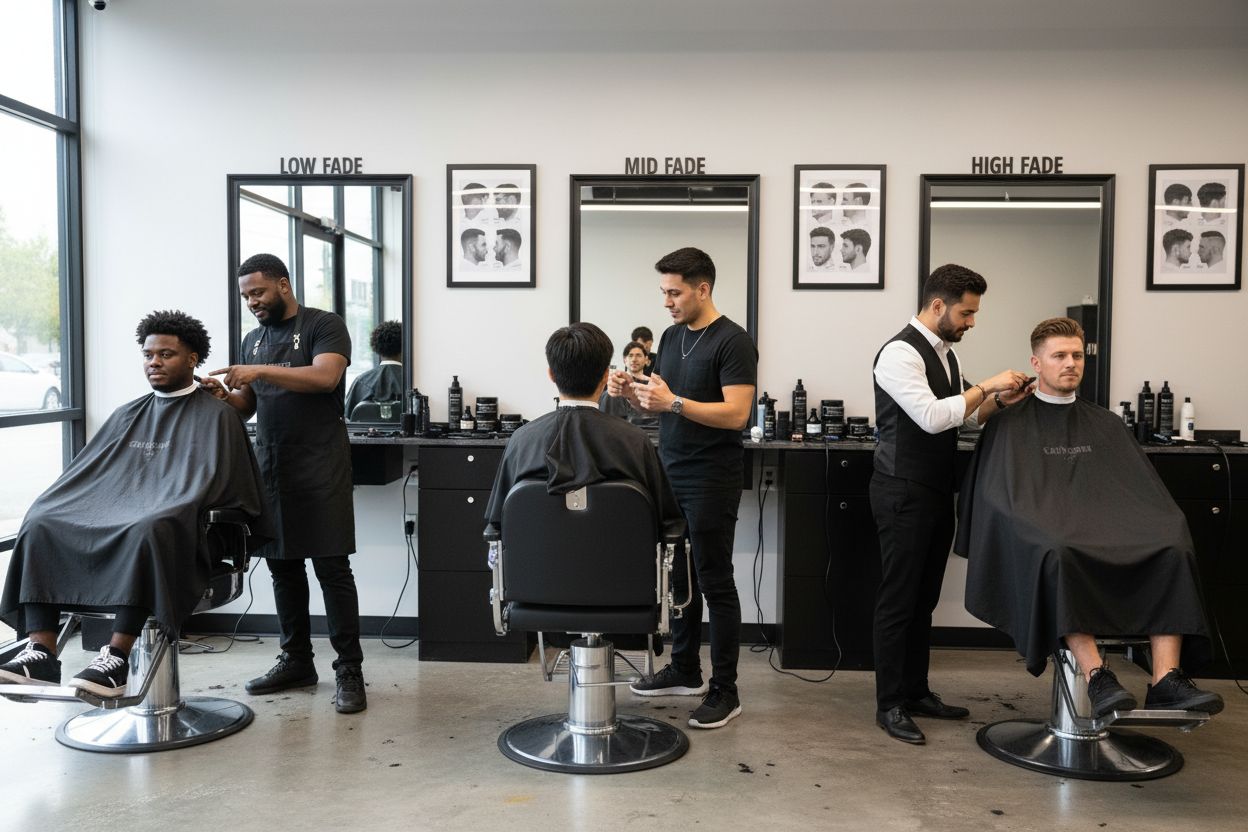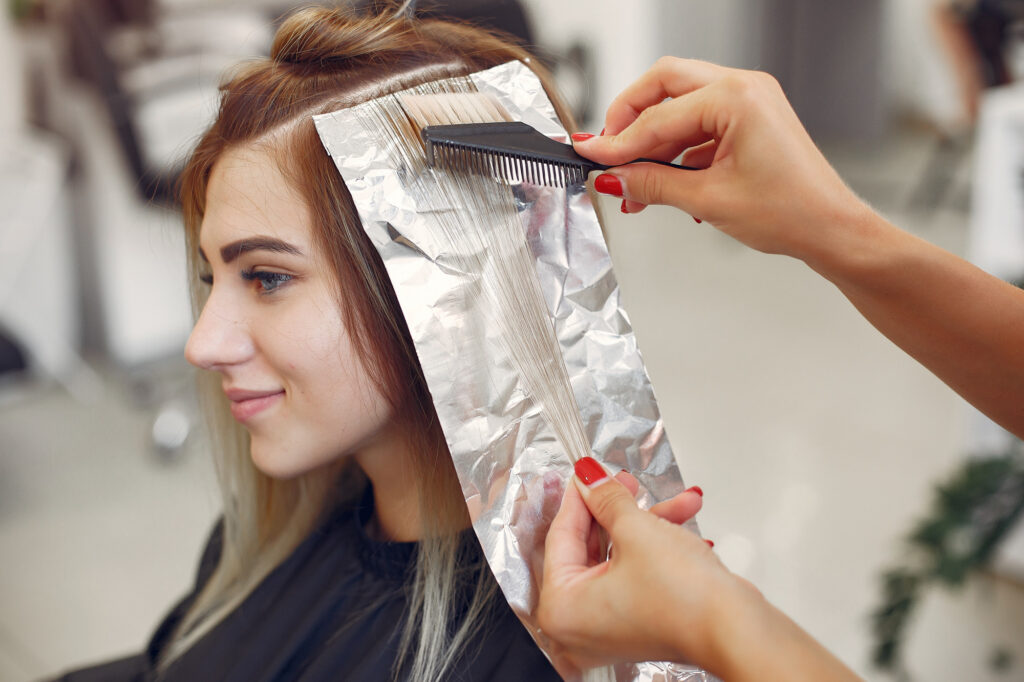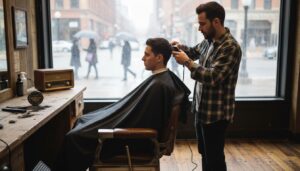Nearly every barbershop features it, and for good reason. Over 60 percent of men choose a fade haircut each year for its clean yet modern appeal. Whether you want a subtle upgrade or a bold shift in style, the fade’s versatility stands out across all hair types. Understanding the details and variations of this cut can help you achieve a sharp look that feels both fresh and tailored to you.
Key Takeaways
| Point | Details |
|---|---|
| Fade Haircut Definition | A fade is a men’s hairstyle with a gradual taper from longer hair on top to shorter sides, requiring expert skill for a seamless look. |
| Types of Fades | Popular fade types include low, mid, high, and skin fades, each offering distinct styles that cater to personal preference and face shape. |
| Fade Creation Process | Achieving a quality fade involves assessing hair, establishing length with clippers, careful blending, and detailed finishing techniques. |
| Maintenance and Styling Tips | Regular touch-ups and the use of lightweight styling products are essential to maintain the fresh appearance of a fade haircut. |
Table of Contents
- What Is A Fade Haircut? Defining The Style
- Popular Types Of Fade Haircuts Explained
- How A Fade Haircut Is Created Step-By-Step
- Styling, Maintenance, And Care Essentials
- Choosing The Right Fade For Your Look
What Is a Fade Haircut? Defining the Style
A fade haircut is a contemporary men’s hairstyle characterized by a precise, seamless transition of hair length from longer on top to progressively shorter towards the sides and back. According to Barber’s Take, this style is defined by its smooth blended gradient that creates a clean, modern aesthetic with sharp visual contrast.
The defining feature of a fade is its gradual tapering effect, where hair length decreases incrementally from top to bottom. Typically, the hair starts longer at the crown and progressively gets shorter, eventually reaching skin level or an extremely close cut near the ears and neckline. This technique requires exceptional skill from a barber to achieve a natural, balanced look without harsh lines or abrupt changes.
- Precision: Requires expert cutting technique
- Versatility: Works with various hair lengths and textures
- Modern Appeal: Provides a sharp, contemporary style
Fades offer remarkable flexibility in styling, ranging from subtle, conservative cuts to bold, dramatic transitions. Whether you prefer a professional look for the office or a edgy style for social settings, a fade can be customized to match your personal aesthetic and hair type. Professional stylists can adjust the fade’s intensity and placement to complement your facial structure and personal style preferences.
Popular Types of Fade Haircuts Explained
Fade haircuts offer incredible diversity, with multiple variations designed to suit different personal styles and preferences. According to Lifestyle PS, the most common types include low fade, mid fade, high fade, skin fade, drop fade, burst fade, and taper fade – each creating a unique visual aesthetic and styling approach.
Here’s a comparison of the most popular fade haircut types and their defining features:
| Fade Type | Starting Point | Visual Impact | Best For |
|---|---|---|---|
| Low Fade | Just above ears | Subtle, natural | Conservative, classic looks |
| Mid Fade | Around temples | Balanced, noticeable | Versatile, most face shapes |
| High Fade | Near the crown | Dramatic, edgy | Modern, bold expressions |
| Skin Fade | Down to bare skin | Ultra-clean, sharp | High-contrast, trendy style |
| Drop Fade | Dips behind ear | Contoured, unique | Accentuating head shape |
| Burst Fade | Around ears, dropped | Rounded flare, distinct | Mohawks, creative cuts |
| Taper Fade | Sideburns, neckline | Gentle, understated | Professional, low-maintenance |
Primary Fade Categories
- Low Fade: Starts just above the ears, providing a subtle transition
- Mid Fade: Begins around the temples, offering balanced contrast
- High Fade: Starts near the crown, creating dramatic visual impact
- Skin Fade: Tapers down to bare skin, delivering an ultra-clean look
Additionally, Barber’s Take highlights specialized fade styles like the shadow fade (soft, subtle transition), temple fade (focused around temples), and undercut fade (sharp contrast with longer top). These variations allow for remarkable personalization, enabling individuals to express their unique personality through their hairstyle.
The choice of fade depends on factors like face shape, hair texture, personal style, and professional environment.
![]() A skilled barber can recommend the most flattering fade type that complements your individual features and aesthetic preferences. Whether you’re seeking a professional look or a bold statement, there’s a fade style waiting to transform your appearance.
A skilled barber can recommend the most flattering fade type that complements your individual features and aesthetic preferences. Whether you’re seeking a professional look or a bold statement, there’s a fade style waiting to transform your appearance.

How a Fade Haircut Is Created Step-by-Step
Creating a fade haircut requires exceptional skill, precision, and a systematic approach that transforms hair through carefully executed techniques. Professional barbers follow a meticulous process that involves multiple specialized tools and cutting methods to achieve the seamless, graduated look that defines a perfect fade.
Fade Creation Process
- Hair Assessment: The barber begins by examining hair texture, density, and growth pattern to determine the most flattering fade style
- Initial Cutting: Clippers with different guard sizes are used to establish the primary length gradation
- Blending Technique: Skilled cutting between clipper lengths creates the smooth, seamless transition characteristic of a fade
- Detailing: Precise trimming around ears and neckline ensures a clean, refined finish
The actual fade creation involves using clippers at multiple angles and lengths, typically starting with a longer guard and progressively moving to shorter guards or no guard at all. Clipper-over-comb and scissor-over-comb techniques allow barbers to create ultra-smooth transitions, eliminating any harsh lines or abrupt length changes. Professional barbers often use a combination of clipper sizes (like #2, #1, and #0) to craft the perfect gradient effect.
Mastering a fade requires years of practice and an understanding of hair mechanics. The most skilled barbers can create virtually invisible transitions that look natural and complement an individual’s unique hair texture and face shape.
Whether you’re seeking a subtle, professional look or a bold, dramatic style, the precision of the fade technique makes all the difference.
Styling, Maintenance, and Care Essentials
Maintaining a fade haircut requires consistent care and strategic grooming to preserve its crisp, clean appearance. According to Allan’s Men’s Hairdressing, keeping your fade looking sharp involves regular touch-ups, specialized hair care, and careful styling techniques.
Key Maintenance Strategies
- Frequency: Schedule barber touch-ups every 2-3 weeks
- Washing: Use sulfate-free shampoo 2-3 times weekly
- Scalp Care: Moisturize regularly to prevent dryness
- Styling Products: Use lightweight matte clay or pomade for texture
As recommended by Barber Group, daily maintenance is crucial. This includes gentle brushing or combing to keep the top section neat, careful trimming of neckline and sideburns, and using styling products that complement your hair’s natural texture. Professional barbers suggest avoiding complete re-fading between appointments to maintain the haircut’s integrity.
Styled products play a significant role in fade maintenance. Choose lightweight, water-based products that provide hold without weighing down the hair or creating an unnatural appearance. Matte finishes work best for most fade styles, offering a natural look while providing enough control to keep your hair looking structured and intentional. Remember, the key to a great fade is not just the initial cut, but consistent, thoughtful maintenance.
Choosing the Right Fade for Your Look
Selecting the perfect fade haircut is an art form that requires understanding your unique facial features, personal style, and hair texture. According to Abbas Barbershop, the key to finding your ideal fade lies in matching the style to your specific face shape.
Fade Recommendations by Face Shape
- Oval Faces: Universal versatility, suits most fade variations
- Round Faces: High fades with volume to add visual structure
- Square Faces: High skin fades to emphasize strong jawline
- Oblong Faces: Low or mid fades with subtle top styling
House of Handsome provides additional nuanced guidance, suggesting specific styling combinations. For instance, square-faced individuals can pair a high fade with a short crop or buzz cut, while those with round faces might opt for a high or mid fade complemented by a voluminous pompadour or quiff to create visual elongation.
Beyond face shape, consider your personal style, professional environment, and hair maintenance commitment. A fade is more than just a haircut – it’s a statement of personal expression. Whether you’re aiming for a sharp professional look or a bold, edgy aesthetic, the right fade can transform your entire appearance and boost your confidence.
Ready to Experience a Perfect Fade Haircut in La Jolla?
The article you just read explains how a fade haircut relies on seamless transitions, personalized styling, and expert precision for a standout result. Many people struggle to find a barber who truly understands the details—like finding the right fade style for your face shape, maintaining sharp lines, or achieving a style that matches your personality and lifestyle. If you have ever felt disappointed by a generic cut that does not flatter your features or simply does not deliver the sharp, professional look you want, you are not alone.
At Joel C Ma Hair Studio, our team of expert hair artists brings over 25 years of experience and creative vision to every fade haircut. We approach each appointment with the same care and detail described in the article, making sure your fade is perfectly blended and matches your unique preferences. Whether you want a subtle low fade or a high-contrast, modern look, our stylists use advanced techniques and personalized consultations to create a style that makes you feel confident every day. Let us help you transform your appearance with a haircut that actually works for you.

Do not settle for average results. Trust your next fade to Joel C Ma Hair Studio and discover what it feels like to walk out with a cut that looks sharp for weeks. Explore our service menu and talented artist team, or book your personalized consultation right now on our main website. Your perfect fade is just a click away—reach out today and experience luxury hair care designed for you.
Frequently Asked Questions
What is a fade haircut?
A fade haircut is a modern men’s hairstyle characterized by a gradual transition from longer hair on top to shorter hair on the sides and back, achieved through a seamless blending technique.
What are the different types of fade haircuts?
Common types of fade haircuts include low fade, mid fade, high fade, skin fade, drop fade, burst fade, and taper fade, each providing a unique look and style.
How is a fade haircut created?
Creating a fade haircut involves a systematic process that includes hair assessment, initial cutting with clippers, blending techniques to create a smooth transition, and detailing around the ears and neckline for a refined finish.
How can I maintain my fade haircut?
To maintain your fade haircut, schedule touch-ups every 2-3 weeks, wash your hair with sulfate-free shampoo, moisturize your scalp regularly, and use lightweight styling products for texture. Daily grooming is also important to keep it looking sharp.





